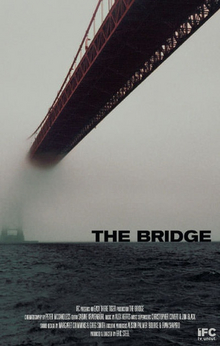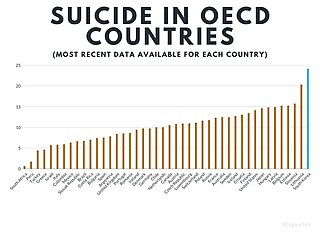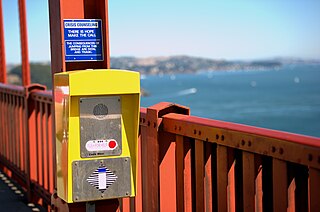
A copycat suicide is defined as an emulation of another suicide that the person attempting suicide knows about either from local knowledge or due to accounts or depictions of the original suicide on television and in other media. The publicized suicide serves as a trigger, in the absence of protective factors, for the next suicide by a susceptible or suggestible person. This is referred to as suicide contagion.
Suicide is the second leading cause of death for people in the United States from the ages of 9 to 56.
A suicide method is any means by which a person may choose to end their life. Suicide attempts do not always result in death, and a non-fatal suicide attempt can leave the person with serious physical injuries, long-term health problems, and brain damage.
A suicide bridge is a bridge used frequently by people to end their lives, most typically by jumping off and into the water or ground below. A fall from the height of a tall bridge into water may be fatal, although some people have survived jumps from high bridges such as the Golden Gate Bridge. However, significant injury or death is far from certain; numerous studies report minimally injured persons who died from drowning.

Suicide prevention is a collection of efforts to reduce the risk of suicide. Suicide is often preventable, and the efforts to prevent it may occur at the individual, relationship, community, and society level. Suicide is a serious public health problem that can have long-lasting effects on individuals, families, and communities. Preventing suicide requires strategies at all levels of society. This includes prevention and protective strategies for individuals, families, and communities. Suicide can be prevented by learning the warning signs, promoting prevention and resilience, and committing to social change.

Suicidal ideation, or suicidal thoughts, is the thought process of having ideas, or ruminations about the possibility of completing suicide. It is not a diagnosis but is a symptom of some mental disorders, use of certain psychoactive drugs, and can also occur in response to adverse life events without the presence of a mental disorder.

The Bridge is a 2006 documentary film by Eric Steel spanning one year of filming at the Golden Gate Bridge which crosses the Golden Gate entrance to San Francisco Bay, connecting the city of San Francisco, California to the Marin Headlands of Marin County, in 2004. The film shows a number of suicides, and features interviews with family and friends of some of the identified people who had thrown themselves from the bridge that year and one person who had jumped previously and survived.

A suicide barrier is a structure intended to deter people from attempting suicide by deliberately jumping from a high place on a structure. Suicide barriers often consist of nets, metal screening, and fencing. Suicide barriers may be placed on tall bridges, observation decks, and other tall structures.
Youth suicide is when a young person, generally categorized as someone below the legal age of majority, deliberately ends their own life. Rates of youth suicide and attempted youth suicide in Western societies and other countries are high. Youth suicide attempts are more common among girls, but adolescent males are the ones who usually carry out suicide. Suicide rates in youths have nearly tripled between the 1960s and 1980s. For example, in Australia suicide is second only to motor vehicle accidents as its leading cause of death for people aged 15 to 25.

Suicide is the act of intentionally causing one's own death. Mental disorders, physical disorders, and substance abuse are risk factors. Some suicides are impulsive acts due to stress, relationship problems, or harassment and bullying. Those who have previously attempted suicide are at a higher risk for future attempts. Effective suicide prevention efforts include limiting access to methods of suicide such as firearms, drugs, and poisons; treating mental disorders and substance abuse; careful media reporting about suicide; improving economic conditions; and dialectical behaviour therapy (DBT). Although crisis hotlines are common resources, their effectiveness has not been well studied.

Suicide in South Korea occurs at the 12th highest rate in the world. South Korea has the highest recorded suicide rate in the OECD. In South Korea, it is estimated to affect 0.02 percent of the population by the WHO. In 2012, suicide was the fourth-highest cause of death. The suicide rate has consistently declined between 2012 and 2019, the year when the latest data are available.

Gender differences in suicide rates have been shown to be significant. There are different rates of suicides and suicidal behavior between males and females. While females more often have suicidal thoughts, males die by suicide more frequently. This discrepancy is also known as the gender paradox in suicide.
World Suicide Prevention Day (WSPD) is an awareness day always observed on 10 September every year, in order to provide worldwide commitment and action to prevent suicides, with various activities around the world since 2003. The International Association for Suicide Prevention (IASP) collaborates with the World Health Organization (WHO) and the World Federation for Mental Health (WFMH) to host World Suicide Prevention Day. In 2011 an estimated 40 countries held awareness events to mark the occasion. According to WHO's Mental Health Atlas released in 2014, no low-income country reported having a national suicide prevention strategy, while less than 10% of lower-middle income countries, and almost a third of upper-middle and high-income countries had.
A suicide attempt is an act in which an individual tries to kill themselves but survives. Mental health professionals discourage describing suicide attempts as "failed" or "unsuccessful", as doing so may imply that a suicide resulting in death is a successful or desirable outcome.

Between 1937 and 2012, an estimated 1,400 bodies were recovered of people who had jumped from the Golden Gate Bridge, located in the San Francisco Bay Area in the United States.
Suicide awareness is a proactive effort to raise awareness around suicidal behaviors. It is focused on reducing social stigmas and ambiguity by bringing attention to suicide statistically and sociologically, and by encouraging positive dialogue and engagement to prevent suicide. Suicide awareness is linked to suicide prevention as both address suicide education and the dissemination of information to ultimately decrease the rate of suicide. Awareness is the first stage that can ease the need for prevention. Awareness signifies a fundamental consciousness of the threat, while prevention focuses on stopping the act. Suicide awareness is not a medical engagement but a combination of medical, social, emotional and financial counseling. Suicide awareness in adolescents focuses on the age group between 10–24 years, beginning with the onset of puberty.

In 2017, the suicide rate in Hong Kong was around 12 deaths per 100,000 people and ranked 32 in the world standing, which was its lowest rate in four years. The suicide rate for males was nearly double that for females, as it was 16.2 deaths per 100,000 males, and 8.8 deaths per 100,000 females. Although it has decreased slightly compared to previous years, for those aged 19 or younger it has risen by 50%. The Samaritans Hong Kong charity has described the issues as worthy of attention.

Rail suicide is deliberate self-harm resulting in death by means of a moving railway vehicle. The suicide occurs when an approaching train hits a suicidal pedestrian jumping onto, lying down on, or wandering or standing on the tracks. Low friction on the tracks makes it impossible for the train to stop quickly enough. This type of suicide may cause trauma to the train driver.













